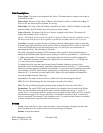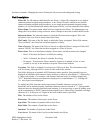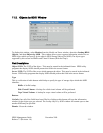Object Type. The type of object being displayed, either File or Directory.
Class of Service. The name of the Class of Service in which the file is stored. If the displayed object is a
directory the value of this field will be NONE.
File Family. The name of the file family to which the file has been assigned. If the file has not been
assigned to a family, the value of this field will be “Not in a family”.
Subsystem Name. The name of the HPSS subsystem which contains the file or directory.
Realm ID. The ID number which identifies the realm which encompasses the file or directory.
Account. The account index that is associated with the file or directory. This value is used by the HPSS
accounting sub-system.
Read Count. This field applies only to files and is the number of read operations that have been issued
against the file. Reading a file through most HPSS interfaces may cause multiple read operations to be
issued, so this value may increase by more than one with each user read of a file.
Write Count. This field applies only to files and is the number of write operations that have been issued
against the file. Writing a file through most HPSS interfaces may cause multiple write operations to be
issued, so this value may increase by more than one with each user write of a file.
Link Count. For directories, this is the count of the number of directories that point to this directory.
This includes Dot and DotDot.
Creation Time. Time and date that the file or directory was created.
Modify Time. Time and date that the metadata associated with the file or directory was last modified.
Last Written Time. This field only applies to files and is the time and date of the last write to the file. If
this field is blank, the file has never been written.
Last Read Time. Time and date of the last read from the file, or the time and date of the last read from
the directory.
Data Length. For directories, this is the byte length of the metadata associated with this directory. For
files, this is the largest numbered byte in the file. Note that this is not necessarily the number of bytes in
the file as files can be written sparsely with gaps. Also, it is not necessarily the highest written byte, since
the Core Server supports POSIX clear and truncate commands which can leave a gap at the end of the
file.
UID. The user ID of the owner of the file or directory.
GID. The group ID of the owner of the file or directory.
Permissions. Permissions granted to the file or directory. These are displayed in the standard UNIX
mode format (read, write, execute permissions for user, group, and other). These are base permissions
and do not take into account the effects of any ACLs on the file or directory.
Option Flags
Don’t Purge. This field applies only to files. If the Don't Purge check box is selected the file is
purge-locked and will not be purged from the top level of the hierarchy. If the Don't Purge
check box is not selected the file may be purged as usual.
HPSS Management Guide November 2009
Release 7.3 (Revision 1.0) 319


















